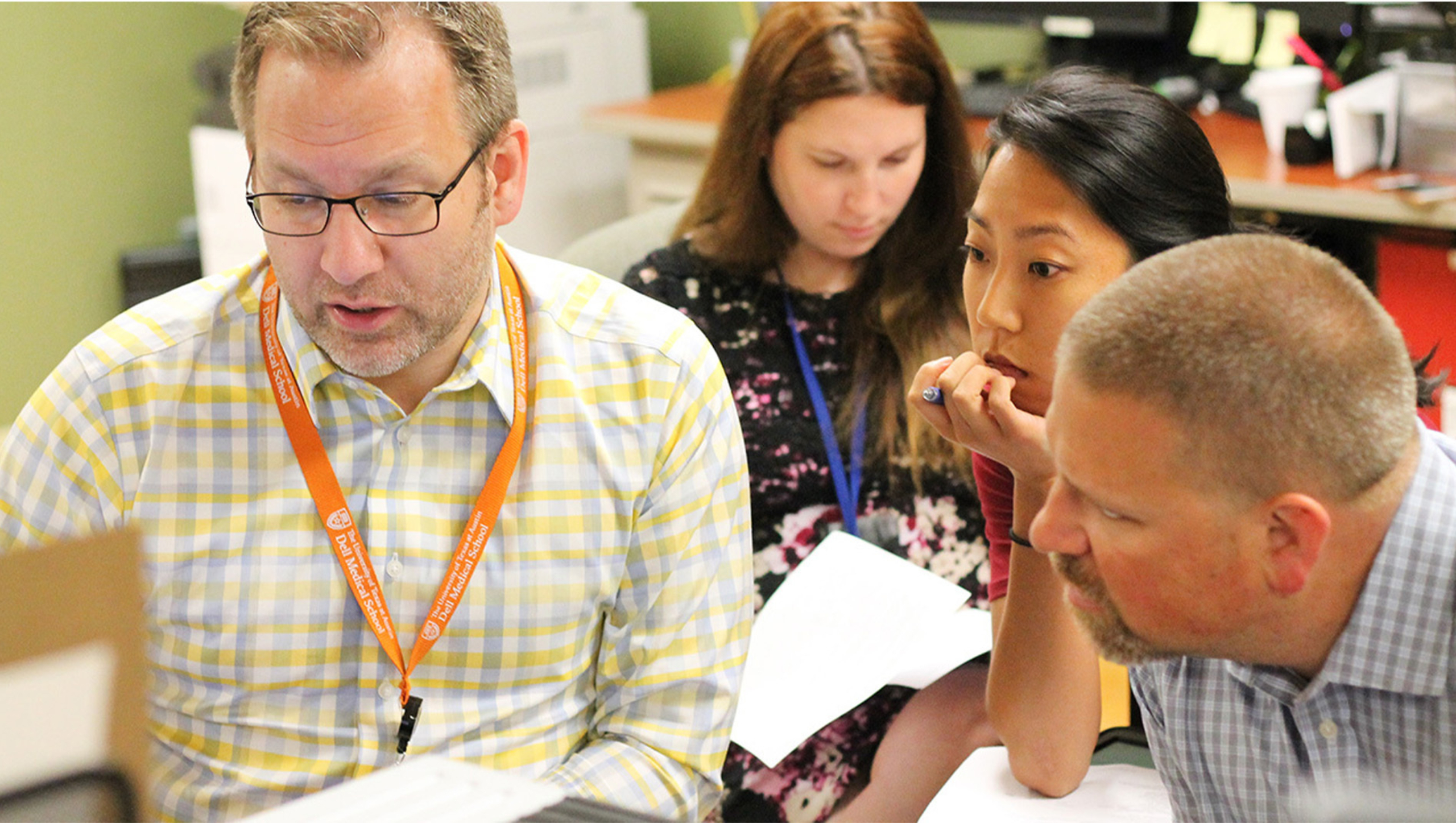A new care team is redefining the patient experience for people with painful conditions, and it may mean fewer doctor visits and better results. See how it works.

The Musculoskeletal Institute care team reviews X-rays of a patient.
Your knee hurts. A lot. After months of hoping it will improve on its own, you finally see a doctor. She refers you to an orthopaedic specialist.
The story branches here. In one scenario, you’re added to a list. A long one. You wait for care. During that time, your pain continues to worsen, to the point that you’re having trouble working. You call in sick. A lot. So many times, in fact, that you lose your job. When the specialty clinic finally tries to schedule your appointment, no one can reach you. Your cell service is disconnected.
Your knee still hurts. A lot.
Another possibility — one that’s new to Central Texas — avoids this by prioritizing patient evaluations.
Karl Koenig, M.D., M.S., leads the effort, which integrates health care professionals from Dell Medical School at The University of Texas at Austin, the Community Care Collaborative and Ascension’s Seton Healthcare Family, in addition to community physicians.
His care team is responsible for trimming the wait for low-income and uninsured people in Travis County seeking relief from conditions such as arthritis, tendonitis and generalized joint pain from more than a year to a matter of weeks.
The doctor will see you now.
Then: Primary care physicians refer patients without insurance or means to pay to a specialty clinic, where they are added to a waiting list. Meanwhile, the primary care physician, aware of the delay his patient is facing, may order an MRI or prescribe narcotics. The MRI may not prove useful to the specialist, and the narcotics may not be the most appropriate treatment.
Those in urgent need of care — who are in such severe pain that they are unable to walk, for instance — are advised to go to the emergency room.
Now: The new care team, working from the Paul Bass Clinic at the retiring University Medical Center Brackenridge while Dell Med’s Health Transformation Building is completed, evaluates those referred to the clinic immediately. Devin Williams, D.C., NP-C, assesses patients’ needs and decides on an initial course of action. Many get a call to schedule an appointment to see a specialist. The average wait? Three weeks.
In some cases, the care team engages the primary care physician to recommend a course of physical therapy or other treatment that the patient can begin right away. If her condition improves, an in-person visit with a specialist may not be necessary. Either way, the care team — what the medical school calls the Musculoskeletal Institute — remains in contact with the primary doctor throughout the process.
What we’re finding is that by working collaboratively with people’s primary care physicians, we’re able to give patients the right care more quickly, using fewer resources. That efficiency is good for the health ecosystem, of course, but it’s also good for individuals, who spend less time waiting and more time living.
Karl Koenig, M.D.
Hey, can I get your number?
Then: In many cases, the only communication between primary care providers and specialists occurs within the pages of the medical record.
Once the patient meets with a specialist, she’s usually scheduled to return for a follow-up appointment, simply as a matter of course.
Now: Primary care physicians at clinics serving those with low incomes or who are uninsured have the mobile phone numbers of care team members. They call to consult the team about abnormal findings, to discuss potential treatment plans and to sound the alarm when a patient is in need of immediate attention.
After the initial specialty appointment — assuming one is necessary — patients are similarly empowered to call the care team to talk about how they’re doing. If they’re improving, a follow-up visit may not be needed, at least not right away.
I came. I saw. I conquered.
Then: Patients and physicians discuss progress, but on a case-by-case basis — and only when patients elect to return for follow-up visits. Generally, data pertaining to outcomes is not aggregated, making evaluations difficult.
The problem is further complicated by the number of individual appointments often required, from X-rays and other imaging to specialist consultations to sessions with physical therapists. Sometimes, people simply get tired of coordinating time off work, transportation and other logistics. They give up.
Now: Patients report — and the care team tracks — whether their condition is improved. They can do so via smartphone and in Spanish. Victory is signaled by the feedback they provide, not the fact that they received treatment.
Importantly, the care team shares these patient-reported outcomes with other patients, who can use the information in making decisions about their own care. The team, in turn, uses it in identifying gaps in service and opportunities for efficiencies. For example, by adding a physical therapist to the team, can patients attend a single appointment to meet with a specialist for evaluation and to work with a therapist to learn the exercises the evaluation indicates? Are they then more likely to do the therapy, and to see benefit in continuing to follow the care team’s recommendations?
When the answer is yes, the story ends like this: Your knee no longer hurts. At least, not a lot.